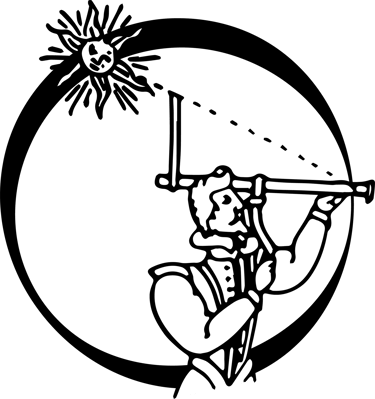HIS STORY
Later Years
In 1613, William Adams was finally given permission to leave Japan if he so desired. However, when the chance actually arose he declined to join Captain Saris on the tedious, long and potentially life-threatening voyage back to England. This did not, however, mean that Adams remained confined by Japan’s borders, as the EIC’s lack of vendible wares meant that the Company needed to follow other Europeans and seek quality trade goods in Asia. Adams made five voyages outside Japan after the Hirado trading post had been established. In these he acted for himself, for the EIC, and while Ieyasu was alive, as a representative of the Japanese ruler himself. Adams' diplomatic skills were being put to ever wider use by the ruling Tokugawa family.
The first of Adams’ Asian voyages, in 1614, was to Siam, a country which enjoyed excellent trading relations with Japan. On the EIC's behalf, Adams bought and fitted out a Chinese-style ship which he named the Sea Adventure and a cargo of English broadcloth, Indian cotton, and African Ivory was loaded. They also carried around £1,250 in cash, worth perhaps US$250,000-300,000 today.
It was the lack of access to proper repair facilities that led to delays in Okinawa in 1615, rather than shoddy workmanship. Also, conflicts were internal—aboard ship, rather than with locals. The mariners resorted to mutiny, for want of advance payment of wages, and so were in open conflict with the merchants on Sea Adventure who were helping fund the voyage. This affair eventually ended with the clandestine murder of the leader of the sailors.
The success of the 1616 Siam voyage saw much profit made by Adams on his own behalf as well as for the EIC. By the end of the voyage, he had reached the end of his contract with the EIC but was persuaded to extend it for one more year. Nevertheless, from now on he would sail in his own vessel, offering space for EIC trade.
On the 1617 voyage to Cochin-China, the southern region of today's Vietnam, Adams and Sayers were extremely disappointed not to meet the King. Adams appears to have enjoyed reasonable trade there on his own behalf, but EIC success was compromised when Sayers had money stolen from him. It is important to remember that from this time onward two trading permits were involved; one solely for Adams’ use and the other for EIC use. Cocks falsely assumed both permits were for EIC use.
William Adams statue in Hirado, Nagasaki Prefecture
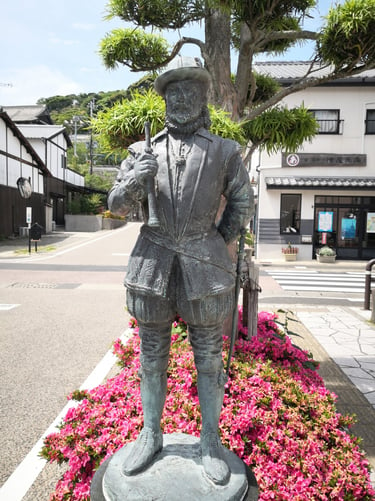

The Sea Adventure left Hirado on November 18th, but made little headway in storms for the first few weeks, subsequently taking shelter at Amami Oshima. The materials they needed for repair were not available there, and they headed for the capital of the Ryukyu Kingdom (now Okinawa Prefecture) Naha, where they tarried until May 1615 while repairs were carried out.
The half year at Ryukyu was not a happy time. It was marked by shoddy repair work, conflict with the locals, mutiny among the crew who worried about their wages being withheld, and distrust among the EIC factors themselves. Adams, as often seems to have been the case, acted as peacemaker and diplomat, salvaging at least something from this sorry state of affairs by loading a cargo of ambergris to take back to Japan.
The Sea Adventure set out once more for Siam on December 6th 1615, and having received permission to proceed to an audience with King Songtham, arrived in Ayutthaya on January 24th 1616 to present him with gifts of Japanese weapons, katana and naginata, high prestige items in Siam.
Trade was successful, and Adams turned a massive profit. He even had to hire two more ships to transport the sappan wood and deer skins back home. Again, Adams acted the diplomat over disagreements in customary rights between the EIC factors and Japanese sailors, angering the English who felt he was too close to the Japanese. Adams was back in Hirado by July of 1616 to be greeted with the sad news of his patron Tokugawa Ieyasu’s death on June 1st.
Ishigaki Island in Okinawa Prefecture

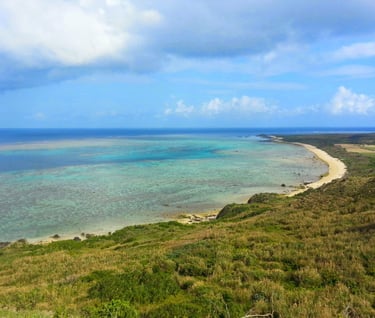
Shortly afterwards, he traveled to Edo for an audience with Ieyasu’s successor Hidetada, to renew the trading privileges enjoyed by both himself and the EIC. The Englishman must have been concerned that his standing would be reduced as the second Tokugawa shogun had his own men around him. Adams no longer automatically enjoyed the high privileges he had under Ieyasu.
Adams was right to be worried. Matters didn't go smoothly at first, and he was made to wait while numerous others were given audiences before him. In the end, the all-important vermillion-seal trade permits were obtained for the EIC. But, there was also a heavy blow, English trade was to be restricted to Hirado only. The trading posts established in other parts of the country such as Sakai and Edo had to be closed.
The stage was set for a third overseas voyage, this time to settle some unfinished EIC business. On March 18th 1614, two of the Hirado EIC factors, Peacock and Carwarden, had left to attempt trade in Cochinchina, modern day south Vietnam. This had in fact been the Hirado factory’s first overseas venture, although Adams had not been involved. The two had never returned and nothing but rumours had been heard of their fate.
On March 23rd 1617, Adams led an expedition to find out what had happened to them. The news was not good. Peacock it seemed had been killed for disrespectful behaviour to the local people and double dealing. Carwarden, hearing the news of his colleague's demise, tried to escape, but his boat had overturned and he drowned. Adams had an audience with the king, received the unwelcome news, engaged in some trade and returned to Hirado after a difficult voyage on August 11th.
Adams set out again for Cochinchina on March 17th 1618. They hit bad weather and the ship was badly damaged, forcing them again to put in at Ryukyu for repairs. The voyage was a write-off, and the ship limped back to Hirado.
Exactly a year later, Adams departed on his last voyage, to Tonkin, now northern Vietnam. The voyage took a month, and one particular incident exemplifies Adams’ compassionate side. He rescued a local man who was found clinging to a solitary plank adrift in the sea, clearly the sole survivor of a wreck. Reading ship's logs of these times, many such poor wretches were simply left to their fate, but Adams showed strength of character, once more, in saving this stranger's life.
The voyage was a modest success, and he returned to Kyushu in August 1619.
Despite Adams’ individual successes in business, and finding his way at court, the trading post was not the pot of gold that the EIC had imagined. A mixture of poor logistics (inbound ships from England were infrequent,) poor product selection (wool was not much needed in Japan, and during peacetime, neither was English weaponry,) poor quality management (a fortune was squandered on entertainment,) and poor business judgment (huge sums of money were wasted on the forlorn hope of obtaining direct access to the Chinese market,) meant that the EIC factors were always in dire economic straits.
William Adams died at Hirado, Nagasaki Prefecture on 16th May 1620. His estate was shared between his family in England and Japan. After Adams death, the last advantage that the EIC enjoyed, a man at court, disappeared, and in 1623 the remaining traders obtained the Shogun’s permission to leave. Trade would continue intermittently on foreign ships via the Siamese trading post, but direct trade did not resume until 1859.
It was previously thought that William Adams was buried within his Yokosuka fief, Hemi, but excavation of another supposed grave site at Hirado took place in the summer of 2017, with funding provided by the Founder and President of the William Adams Club Robin James Maynard MBE. A European-style grave was discovered and found to be one previously excavated in the 1930s. Only 5% of the skeleton survived due to the extremely harsh soil conditions, and the bones had been placed in a twentieth-century urn. These were mostly skull and leg fragments. Forensic analysis soon revealed that the "owner" had been Caucasian (of north and west European origin), male, middle-aged, and had probably died and been buried between 1590 and 1620. Subsequent investigations at the site revealed that, amongst many other graves there, this was the only Western-style burial. The site (near the top of Sakigata Hill) was definitely not part of the ‘English cemetery’ in Hirado (nor the Dutch one.) Examination of historical records suggested the burial was almost certainly that of William Adams, and most unlikely to have been that of one of two other English sailors who died in Hirado at the relevant time, and whose place of burial was unknown.
In December, 2020 the final forensic report was published in the globally-renowned scientific journal, Nature. The findings further revealed that, based on diet, the individual must have lived in Japan for at least ten years. This finding totally eliminated the possibility of the bones belonging to a visiting sailor, leading to the definitive conclusion that these were indeed the bones of William Adams.
William Adams, explorer, father, husband, vassal, lord, ambassador, businessman, navigator and captain, lives on in people’s hearts and minds.
A perfect example of a man who adapted to circumstances, and thrived through hard work, dedication and a desire to do the right thing as he saw it.
A most worthy soul to commemorate.

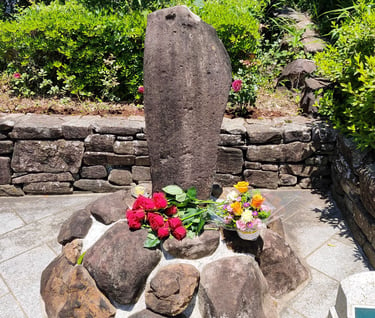
William Adams' grave in Hirado, Nagasaki Prefecture

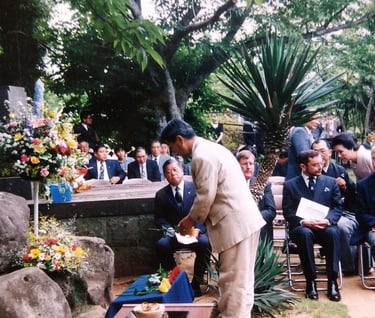
The second Anjin Kai memorial service to William Adams. A key front row guest, holding a white folder and looking very smart, is lan de Stains who was then Executive Director of the British Chamber of Commerce in Japan. lan was later awarded the OBE and volunteered to join Robin James Maynard MBE as Joint Chairman to launch The William Adams Club in September 2015. Tragically, lan's health rapidly deteriorated and he died in December 2018.
